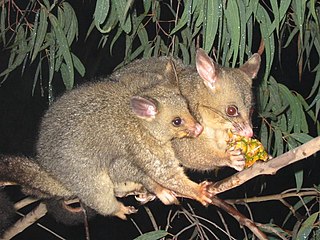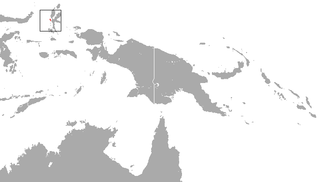
Phalangeriformes is a paraphyletic suborder of about 70 species of small to medium-sized arboreal marsupials native to Australia, New Guinea, and Sulawesi. The species are commonly known as possums, gliders, and cuscus. The common name "possum" for various Phalangeriformes species derives from the creatures' resemblance to the opossums of the Americas. However, although opossums are also marsupials, Australasian possums are more closely related to other Australasian marsupials such as kangaroos.

The southern common cuscus, also known as Australian cuscus, gray phalanger, and to-ili, is an arboreal marsupial endemic to Australia, southern New Guinea and possibly the Aru Islands. Until recently, it was considered conspecific with P. intercastellanus, and before that also with P. orientalis.

The common echymipera, or common spiny bandicoot, is a bandicoot. It is long-snouted even by bandicoot standards. The upper parts are a coarse reddish brown, flecked with spiny buff and black hairs. The tail is short and almost hairless. Length varies between 300 and 400 mm, with the tail accounting for an additional 80 to 100 mm; weight is from 600 to 2000 g.

The eastern pygmy possum is a diprotodont marsupial of south-eastern Australia. Occurring from southern Queensland to eastern South Australia and also Tasmania, it is found in a range of habitats, including rainforest, sclerophyll forest, woodland and heath.

Phalanger is a genus of possums. Its members are found on New Guinea, the Maluku Islands, other nearby small islands, and Australia's Cape York Peninsula. They are marsupials of the family Phalangeridae, and are one of the four genera whose species are commonly referred to as cuscuses.

The Sulawesi bear cuscus, also known as the Sulawesi bear phalanger, is a species of arboreal marsupial in the family Phalangeridae endemic to Sulawesi and nearby islands in Indonesia. It lives in tropical moist lowland forest at elevations up to 600 m and is diurnal, folivorous and often found in pairs. A. ursinus is threatened by hunting, collection for the pet trade and deforestation.

The Gebe cuscus is a species of marsupial in the family Phalangeridae. It is endemic to the island of Gebe, North Maluku province, Indonesia, where it lives at elevations from sea level to 300 m.

The mountain cuscus is a species of marsupial in the family Phalangeridae found in West Papua, Indonesia and Papua New Guinea.

The ground cuscus is a marsupial from the order Diprotodontia and belongs within the family Phalangeridae, a diverse family consisting of the other cuscus species and the brushtail possums and the scaly-tailed possum.

The Woodlark cuscus is a species of marsupial in the family Phalangeridae endemic to Papua New Guinea, specifically on Madau and Woodlark Island, a part of the Milne Bay Province of Papua New Guinea. It happens to be the largest mammal living on Woodlark Island but it is also found on the neighboring island of Alcester, 70 kilometers south of Woodlark Island.

The northern common cuscus, also known as the gray cuscus, is a species of marsupial in the family Phalangeridae native to northern New Guinea and adjacent smaller islands, but is now also found in the Bismarck Archipelago, southeast and central Moluccas, the Solomons, and Timor, where it is believed to have been introduced in prehistoric times from New Guinea. It was formerly considered conspecific with the allopatric P. intercastellanus and P. mimicus.

The ornate cuscus or Molluccan cuscus is a species of marsupial in the family Phalangeridae. It is endemic to Indonesia, where it is found on the North Maluku islands of Halmahera, Bacan and Morotai, at elevations from sea level to 1000 m.

Rothschild's cuscus, also called the Obi Island cuscus, is a species of marsupial in the family Phalangeridae. It is endemic to the islands of Obi, Bisa and Obilatu in the Obi Islands of Maluku province, Indonesia.

The silky cuscus is a species of marsupial in the family Phalangeridae. It is found in Indonesia and Papua New Guinea.

Stein's cuscus is a species of marsupial in the family Phalangeridae. It is found in Indonesia and Papua New Guinea.

The Waigeou cuscus or Waigeou spotted cuscus is a species of marsupial in the family Phalangeridae. It is endemic to the island of Waigeo in Indonesia, and consequently the spelling Waigeo cuscus is often used instead of Waigeou cuscus. Unlike all other members of the genus Spilocuscus, both genders are whitish with black spots. It remains fairly common, but its small range makes it vulnerable to habitat loss and hunting.

The Phalangeridae are a family of mostly nocturnal marsupials native to Australia, New Guinea, and Eastern Indonesia, including the cuscuses, brushtail possums, and their close relatives. Considered a type of possum, most species are arboreal, and they inhabit a wide range of forest habitats from alpine woodland to eucalypt forest and tropical jungle. Many species have been introduced to various non-native habitats by humans for thousands of years.
Cuscus is the common name generally given to the species within the four genera of Australasian possum of the family Phalangeridae with the most tropical distribution:

The blue-eyed cuscus is a species of marsupial in the family Phalangeridae. It is endemic to the two small islands of Ternate and Tidore, west of the island of Halmahera in North Maluku province, Indonesia.


















